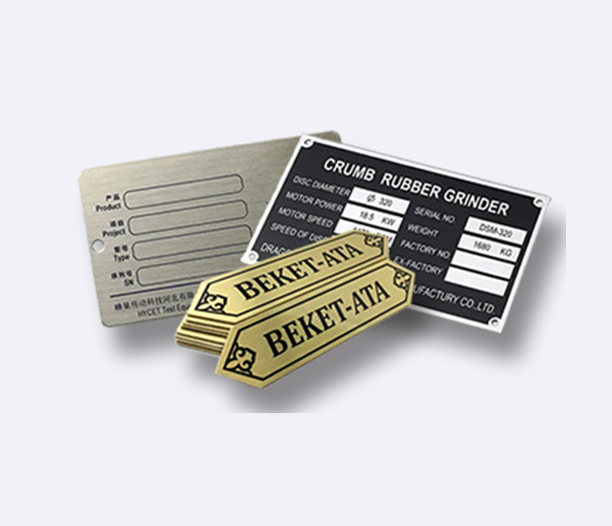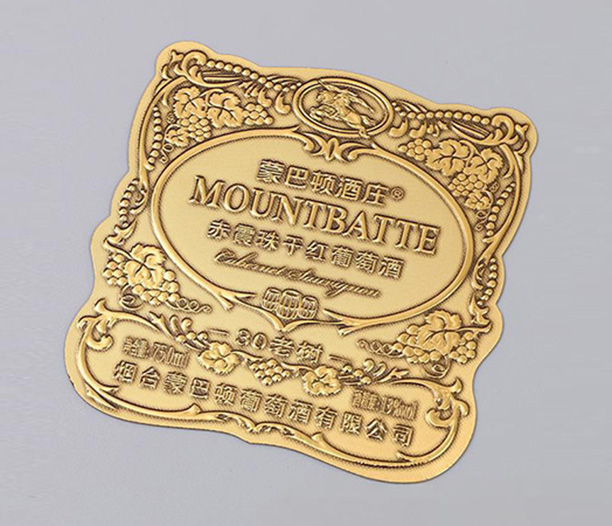If you’re in the market for etched name plates, you’ve probably noticed that material choice is a big deal. Metal or plastic? Each has its pros and cons, and the “right” pick depends on your specific needs—whether it’s durability, aesthetics, budget, or environment. In this guide, we’ll break down the differences between metal and plastic etched name plates, helping you make an informed decision that aligns with your project goals.
1. What Are Etched Name Plates?
Let’s start with the basics. Etched name plates are engraved signage used for identification, branding, or labeling. The etching process involves removing material (via laser, chemical, or mechanical methods) to create permanent, high-contrast text or designs. These plates are popular in industries like manufacturing, aerospace, healthcare, and even consumer goods because they’re durable, professional-looking, and customizable.
The keyword here is permanence. Unlike printed labels, etched name plates won’t fade, peel, or scratch off easily. But the material you choose—metal or plastic—plays a huge role in their performance and longevity.

2. Metal Etched Name Plates: Strength and Prestige
Metal etched name plates are the go-to for projects where durability and a premium look matter. Common metals include stainless steel, aluminum, brass, and bronze. Let’s dive into why metal might be your best bet:
- Durability: Metal plates can withstand extreme temperatures, UV exposure, chemicals, and physical wear. They’re ideal for harsh environments like outdoor machinery, industrial equipment, or marine applications.
- Professional Aesthetics: Nothing says “high-end” like a polished stainless steel or brushed aluminum name plate. They add a touch of sophistication to luxury products, corporate signage, or commemorative plaques.
- Longevity: Metal doesn’t warp, crack, or degrade over time. A well-made metal etched name plate could last decades with minimal maintenance.
That said, metal isn’t perfect. It’s heavier, costlier to produce, and may require protective coatings (like powder coating) to prevent corrosion in certain environments. If budget is tight or weight is a concern, plastic might be worth considering.
3. Plastic Etched Name Plates: Lightweight and Budget-Friendly
Plastic etched name plates are a versatile alternative, especially for indoor or lightweight applications. Materials like acrylic, polycarbonate, and ABS are popular choices. Here’s where plastic shines:
- Affordability: Plastic is cheaper to produce, making it ideal for large batches or projects with tight budgets.
- Lightweight Design: Need a name plate for electronics, medical devices, or retail displays? Plastic won’t add bulk or strain mounting surfaces.
- Chemical Resistance: Certain plastics, like polycarbonate, resist oils, solvents, and cleaning agents better than some metals. This makes them great for labs, kitchens, or medical settings.
- Customization: Plastic can be dyed, painted, or backlit for creative designs. Want neon lettering or translucent effects? Plastic delivers.
On the flip side, plastic etched name plates aren’t as tough as metal. They can scratch, discolor under UV light, or warp in high heat. For outdoor use or heavy machinery, metal is still king.
4. Key Factors to Consider When Choosing
So, how do you decide? Let’s compare metal and plastic etched name plates across five critical factors:
- Environment:Metal: Choose for outdoors, high-heat areas, or corrosive settings (e.g., chemical plants).Plastic: Opt for indoor, controlled environments (e.g., offices, electronics).
- Budget:Metal: Higher upfront cost but lower lifetime expenses due to durability.Plastic: Lower initial price but may need replacing sooner.
- Aesthetics:Metal: Sleek, professional, and timeless.Plastic: Vibrant colors and modern finishes.
- Weight Restrictions:Metal: Avoid if mounting on fragile surfaces.Plastic: Perfect for lightweight applications.
- Customization:Both materials offer etching precision, but plastic allows for more color/finish experimentation.
5. The Etching Process: Does Material Matter?
Absolutely! The etching method varies slightly between metal and plastic:
- Metal Etching: Often uses chemical or laser etching to create deep, precise grooves. The result is a rugged, tamper-proof finish.
- Plastic Etching: Typically done with lasers, which “frost” the surface without cutting deeply. This preserves structural integrity but may lack the tactile depth of metal.
Pro Tip: Work with a vendor experienced in your chosen material. Poor etching can lead to blurry text or weak durability.
6. Real-World Applications
Still on the fence? Let’s look at common use cases:
- Metal Etched Name Plates:Industrial machinery ID tagsMilitary or aerospace equipment labelsMemorial plaques or building directories
- Plastic Etched Name Plates:Office door signsMedical device labelingConsumer product branding (e.g., appliances, tech gadgets)

7. Maintenance and Care
To maximize the lifespan of your etched name plates:
- Metal: Wipe with a damp cloth; avoid abrasive cleaners. Apply wax or oil occasionally to prevent tarnishing.
- Plastic: Clean with mild soap and water. Avoid solvents that could cloud or damage the surface.
8. Sustainability Considerations
Eco-conscious? Both materials have trade-offs:
- Metal is recyclable but energy-intensive to produce.
- Plastic is lightweight (reducing shipping emissions) but often ends up in landfills.
Ask suppliers about recycled content or take-back programs!
Final Verdict: Which Etched Name Plate Is Right for You?
There’s no one-size-fits-all answer. If you need rugged durability and a premium look, metal etched name plates are worth the investment. For budget-friendly, colorful, or lightweight solutions, plastic etched name plates get the job done.
Before ordering, request samples to test durability, readability, and aesthetics in your specific environment. And remember: A well-chosen etched name plate isn’t just a label—it’s a long-term asset for your brand or project.






